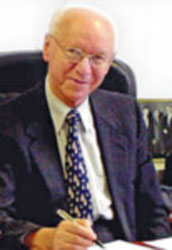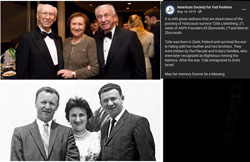Eli (Eliezer) Zborowski a Holocaust Survivor

Birth:
September 20, 1925
?arki, Chrzanów County, Malopolskie, Poland
Death:
September 10, 2012 (86)
Queens, Queens County, NY, United States
Place of Burial:
New Montefiore Cemetery
Immediate Family:
Son of Moszek Zborowski and Zysla "Elizabeth" Zborowska
Husband of Diana Zborowski and Elizabeth Zborowski
Father of Murry Zborowski and Dr. Lilly Zborowski Naveh
Brother of Mendel "Marvin Henry" Zborowski and Cilla "Tzila" Listenberg

Zborowski
siblings
alt. birth date 8 Dec 1921
Eli Zborowski, 86, Leader in Holocaust Remembrance, Dies
Eli Zborowski, a survivor of the Holocaust who made it his mission to ensure that it would never be forgotten, founded an American organization to support Israel’s official Holocaust memorial and raised more than $100 million for it, died on Monday in Queens. He was 86.
He founded the American Society for Yad Vashem. The cause was cardiac arrest, said Rochel Berman, who, with her husband, George, published a biography of Mr. Zborowski last year.
Mr. Zborowski (pronounced zbor-AHV-skee) started the American and International Societies for Yad Vashem, the Israeli memorial, in 1953, a year after he arrived in the United States as a penniless Jewish immigrant from Poland with little knowledge of English. He was the founding and only chairman of what was — in fact, if not in name — a single organization. Under him, it grew to 50,000 members.
Mr. Zborowski served on the board of the memorial and helped come up with the idea, which it adopted, of remembering communities, not just individuals, lost in the Holocaust.
He also founded the American Federation of Jewish Fighters, Camp Inmates and Nazi Victims, and was one of six survivors — and the only American — to greet Pope John Paul II during his visit to Yad Vashem in 2000.
Mr. Zborowski and his wife, Diana, established a chair in Holocaust studies at Yeshiva University in Manhattan in 1976, the first such professorship in the country. He started a newspaper on Holocaust issues, Martyrdom and Resistance, which has been published for 37 years.
Presidents Jimmy Carter and Ronald Reagan appointed him to the United States Holocaust Memorial Council, and Mayor Edward I. Koch named him to the New York Permanent Commission on the Holocaust. Among many campaigns, he fought for compensation for victims of Nazi medical experiments and the return of property seized from Jews during World War II.
He also started a program for younger members of the American Society for Yad Vashem, mainly descendants of survivors, to keep the memory of the Holocaust alive.
Eliezer Zborowski was born in Zarki, Poland, on Sept. 20, 1925. In 1939, at the war’s beginning, Nazis confined his family in a ghetto they created for Jews. Taking advantage of his fair complexion and forged papers identifying him as a gentile, Mr. Zborowski acted as a courier between the ghetto and other Poles opposed to the occupiers.
When the Nazis’ program to exterminate Jews and other minorities began in 1942, the ghettos were liquidated. Mr. Zborowski and his family were hidden by Christians in an attic and a chicken coop. His father was separated from the family and shot while trying to escape from a German work camp.
After the war, Mr. Zborowski helped smuggle Jews to British-ruled Palestine. In one instance, he encountered a train car containing 100 teenagers and took them to safety at a camp for displaced persons in Germany. At the camp, he set up a youth center to care for them, and it became a model for others set up at other camps. He then helped the youths immigrate to what was soon to be Israel.
Mr. Zborowski had planned to settle in Israel himself, but he had met and married Diana Wilf, whose asthma was aggravated by the Middle Eastern climate. They came to New York in 1952, and Mr. Zborowski imported camera parts from Germany, then began trading in currency. The currency business took him to Latin America, where he set up a company to distribute Sheaffer pens. He later expanded into other businesses, including commercial real estate in New York and the distribution of cellphones in Latin America.
In their biography, “A Life of Leadership: Eli Zborowski,” the Bermans said Mr. Zborowski had taken up the cause of Holocaust remembrance because he believed that few survivors wanted to talk about it and that few Americans wanted to hear about it. An early success in the mid-1950s was getting Jewish schools to require Holocaust studies. He became involved in Yad Vashem during visits to his sister in Israel.
Mr. Zborowski’s wife, Diana, died in 2004. He is survived by his second wife, the former Elizabeth Mundlak, who is also a Holocaust survivor; his daughter, Lilly Zborowski Naveh; his son, Murry; his brother, Marvin; his sister, Tzila Listenberg; and seven grandchildren. He lived in Forest Hills, Queens.
In 2000, when the pope visited Yad Vashem, some criticized him for declining to comment directly on the church’s silence about Hitler’s crimes during the war. But Mr. Zborowski complimented the pope, saying the visit was a momentous gesture.
Mr. Zborowski’s biographers said his magnanimity extended even to German soldiers who had been captured after the war and had nothing to eat or drink. He gave them water.
“I don’t know why I did it,” Mr. Zborowski said, “and to this day I do not regret it.”